When you’re considering a shopping decision, whether that’s a shoe or a software tool, do you look at who’s created the product? Most customers do.

When you trust a brand to create a quality product, where does that trust come from? It comes from good product experience and good customer experience. How does this experience get created, consistently? One word — communication!
Communication is the core strength (or weakness) of any team and organization and it directly reflects on the products that they create. How? Let’s find out.
Conway’s law draws a direct correlation between the internal communications of a company and its outcome. It brings attention to how internal communications are set up, how efficient they are, and how they ultimately impact the results and goals of the company. Although this law is popular in the software industry, it is widely used in other industries to design and develop products:
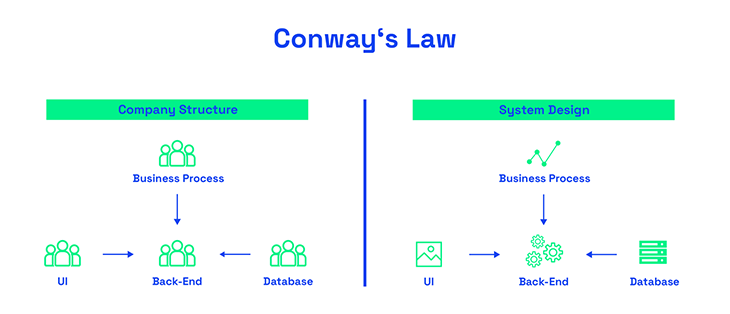
Melvin Conway, a computer programmer, made notable contributions in the areas of software development, computer science, and programming languages in the 1900s. He published an IT theory in 1968, stating that “Any organization that designs a system (defined broadly) will produce a design whose structure is a copy of the organization’s communication structure.”
What Conway means is that businesses tend to design product architectures that resemble their own teams’ communication structures, patterns, and social dynamics.
Product managers are usually central hubs of communication, promoting and facilitating interactions not only within their own product-development team but also cross-functionally with other teams across the organization.
Conway’s law directly impacts the output of the organization based on the communication structure and thus is relevant to product managers. Per the law, better product design and development is a direct outcome of efficient internal communications.
In product management, a lot of problems can be resolved, or better yet avoided altogether, with effective communication. When things get lost in translation or simply forgotten, it can sometimes cause critical problems, often having a domino effect on product development.
Understanding the importance of timely and efficient communication can be game-changing not just for product managers, but companies as a whole, resulting in great quality products with proper management of resources.
Conway drew upon his own experiences working on big software projects to observe a consistent pattern — the architecture of the software product often mirrored the organizational structure and the communication patterns of the team responsible for developing the product.
Through his research, he found that sometimes teams were organized into separate departments that each acted as functional units, and these teams produced software with a similar modular structure. Different teams would be responsible for building different modules, bringing them together at the end. On the flip side, teams that had strong communication and cross-functional collaboration tended to develop more cohesive and integrated products.
The organizational structure can also impact the scalability and adaptability of the software architecture. If the company’s organizational structure promotes scalability and adaptability through agile processes and cross-functional team collaboration, the software architecture mirrors this and will most likely be scalable and adaptable to product growth.
On the other hand, a more rigid organizational structure would result in a less flexible, monolithic software architecture. It’s important for product managers to recognize the influences of organizational structure on product architecture.
To align your team structure with your desired product outcomes, consider the following strategies based on Conway’s law:
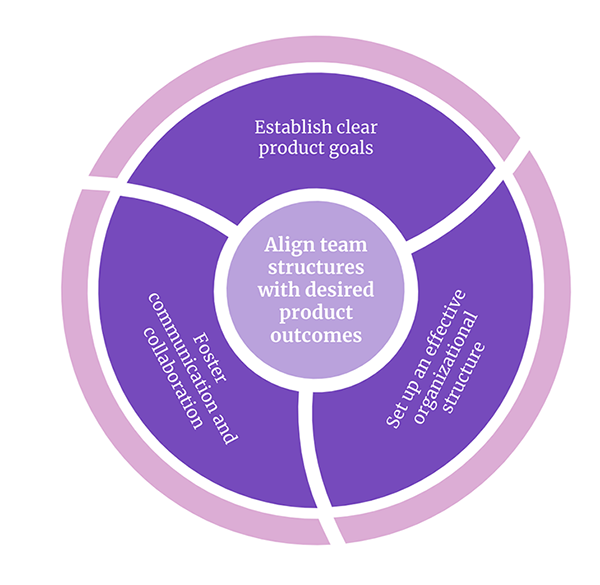
As a product manager, you want to define clear product goals and outcomes, and communicate them effectively across your company. This creates a shared understanding of product vision and the customer problems you aim to solve. This clarity will give the guidance needed to set up the right organizational structure and effective communication channels across the company
Based on what your product vision is and what your goals are, you want to create an appropriate and effective organizational structure. You might even want to consider flattening your organization structure to remove bottleneck hierarchical layers and promote more open communication.
Set up a structure that accommodates scalability and adaptability, since this will directly impact the outcome of product development.
Create an environment of open communication and strong cross-functional collaboration through regular meetings, standups, retrospectives, workshops, team bonding activities, and more. Guide teams to cross-pollinate and learn from each other. Help them develop a shared sense of purpose — this will bring the teams closer and they will work effectively together.
Conway’s law has a direct correlation between product development and team collaboration. How can we have a positive influence on team collaboration, so that it ultimately has a positive impact on the outcome and quality of the product? Here are some strategies you can use:
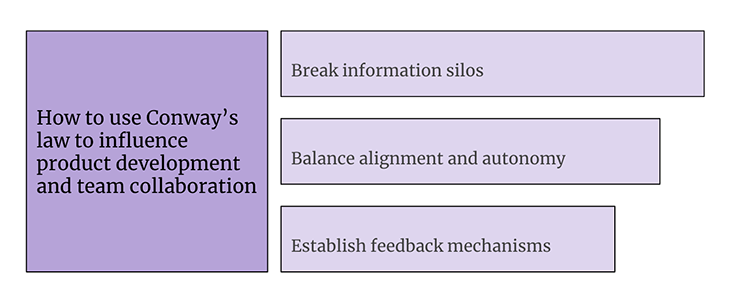
Oftentimes, specific teams or individuals become knowledge islands since they are working on the same project or related projects for longer durations. This hinders team communication because other team members don’t have enough information to have a substantial impact on critical decision-making criteria.
It’s important to break these information silos and encourage open and timely communication between all team members and cross-functional teams.
It is important to make teams autonomous but it’s also important to help teams align with the product vision. Once teams have a clear and shared understanding of the product goals, making them autonomous to pave the path to get there, will help encourage innovation and productivity.
Finding that balance and keeping team members on track is management’s responsibility. Regular check-ins with your teams will help with this.
Identifying and understanding problems, bottlenecks, and conflicts will guide you to set up the right organizational structure and communication channels that work for your team members. It will also help you achieve your product goals effectively in the end.
Establish feedback mechanisms that will help you source this feedback from team members regularly and work with a core committee to incorporate this feedback into your workflows. Involve your team members to help set up effective feedback loops.
There are many different strategies you can leverage for effective product management based on Conway’s law. Some of these are:
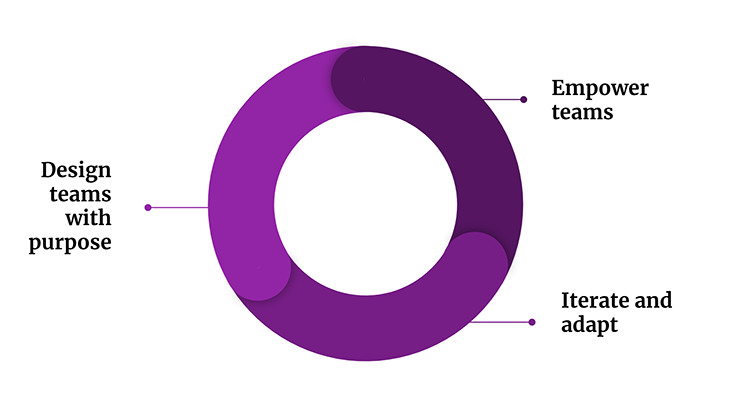
To foster open communication and cross-functional collaboration that bring diverse skills and expertise to product development, and design team structures that align with the desired product architecture and interaction patterns.
Promote a culture of team collaboration, open communication, and knowledge sharing, with a shared purpose and core values. When teams feel like they are working towards one goal, they will be more inclined to work together to reach that goal.
Encourage and empower teams to have end-to-end ownership, responsibility, and autonomy of the products they develop. Enable them to make informed decisions and contribute to the product’s design and development from different perspectives. This will encourage innovation and motivate teams to work together.
Sometimes we think we’re empowering teams, but we’re actually not, it’s important to gather feedback and analyze our strategies from time to time.
It’s important to continuously gather feedback from customers, stakeholders, and team members to identify areas of improvement. Once you have analyzed the feedback, embrace an iterative and adaptive approach to product development, team structures, communication channels, collaboration patterns, social dynamics, and more.
You don’t have to implement everything at one time, but every iteration takes you closer to your desired product goals and outcome.
Many companies have successfully applied Conway’s law in their culture and day-to-day workflows. Here are some notable examples:
Spotify has set up an organizational structure that increases innovation and productivity by promoting a culture of autonomy, collaboration, and shared ownership.
Teams are organized into squads, tribes, chapters, and guilds that consist of people with different skill sets working together to achieve product goals. They are intentionally set up to foster cross-functional collaboration and incorporate agile methodologies. This helped them scale efficiently and move quickly, without too much overhead.
Amazon has created an environment of scalability with efficiency. They have a simple rule — every internal team should be small enough so that they can be fed with only two pizzas. The idea behind this concept is that smaller teams communicate and work more effectively with each other.
These teams are decentralized, independent, and have end-to-end ownership of a specific product or service, consisting of everything from development to operations. This helped Amazon scale multiple businesses successfully, including AWS.
Netflix encourages a people-first culture, where employees explore new ideas and pursue new ways of achieving their goals. Their organizational structure includes small, independent teams with a high level of freedom and responsibility. They develop highly modular and scalable architecture through effective communication and collaboration, aligning their efforts to build a highly cohesive streaming platform with a great user experience.
Their open and intentional information-sharing practices help teams reach their goals quickly and efficiently.
Incorporating Conway’s law in your organizational structure and culture can be quite challenging, but there are ways to overcome them. Here are some potential challenges you should watch out for:
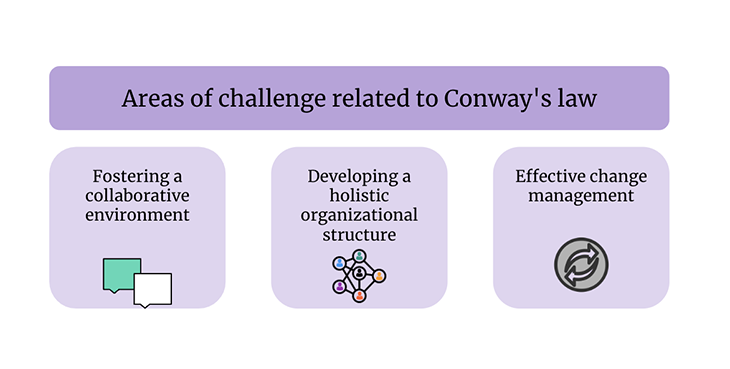
Creating an environment that promotes open communication and cross-functional collaboration is not easy. You need to foster a culture of trust, respect, and psychological safety to encourage team members to voice their opinions freely and collaborate effectively.
Creating clear and open communication channels and coordination mechanisms, such as visible Slack channels, instead of long email threads, will remove communication barriers and promote collaboration between team members.
While we should look at our organizational structure through Conway’s lens, it should be complemented with a more holistic approach, encompassing all other factors that contribute to a product’s success. It’s important to identify factors like customer needs, market trends, technology growth, and more, that can impact the outcome of your product development.
These need to be balanced with the strategies that will promote open communication and positive social dynamics within the company.
Not everybody responds to change effectively. Implementing changes to organizational structure and communication patterns can be met with resistance. Overcoming this resistance requires effective change management.
Involve your team members in the decision-making processes and provide both support and training to help them adapt to new workflows. Clearly communicate the rationale behind the changes, why it’s important, and the benefits they will bring. Create a shared sense of purpose and understanding, this will go a long way.
When you embrace Conway’s law and understand its influences on organizational structure and social dynamics, you can benefit from its direct correlation with product outcome and quality. Here are some ways you can help your organization commit to leveraging Conway’s law:
When people understand the “why” behind a concept, they will be more willing to acknowledge it. Create a deep understanding of Conway’s law and its implications on product design and development. Identify the organizational structure and communication patterns in your company that will impact the resulting product architecture.
By being more aware, you can proactively shape team structures and communication channels to align with your desired product goals and outcomes.
Introduce monetary and heart-driven incentives that align with your product goals and promote open communication, strong collaboration, and positive social dynamics.
Create a clear and shared understanding of the product vision, develop a shared purpose, and encourage a unified front to meet product objectives. This will not only help incorporate Conway’s law effectively, but it will also shape the future growth of the company.
Nothing is ever constant — the market keeps shifting, technology grows, and your customers’ needs will change over time. Continuously learning and adapting to market research, technology insights, customer feedback, and team collaboration will help you embrace a more iterative and adaptive approach to product design and development. Documenting changes and lessons learned will give you further valuable insights over time.
When you want to give your customers the best user experience and want to do it consistently, Conway’s law can help you get there. Your product outcome and quality are directly impacted by the organization structure, communication and collaboration patterns, and social dynamics of your internal teams. When you make your company’s internal environment better, your product architecture also becomes stronger!
Conway’s law also emphasizes that the whole company is responsible for the company’s outcome, not just one team or one individual. Teams need to come together and work together to achieve shared product goals. Creating awareness and advocating the “why” behind Conways’ Law will help create that shared purpose and build the foundation you need to make your products awesome!
Featured image source: IconScout

LogRocket identifies friction points in the user experience so you can make informed decisions about product and design changes that must happen to hit your goals.
With LogRocket, you can understand the scope of the issues affecting your product and prioritize the changes that need to be made. LogRocket simplifies workflows by allowing Engineering, Product, UX, and Design teams to work from the same data as you, eliminating any confusion about what needs to be done.
Get your teams on the same page — try LogRocket today.

Stop letting unreliable data block features. Treat data as inventory to track quality, ownership, and ship with confidence.

Learn why slide decks slow teams down and explore better tools like whiteboards, PRDs, and prototypes to improve collaboration and alignment.

AI PM roles are evolving fast. Learn the five types of AI PMs, the skills they need, and how they shape AI products across industries.

Learn how you can use AI agents to automate workflows, boost productivity, and choose the right tools while avoiding common pitfalls.